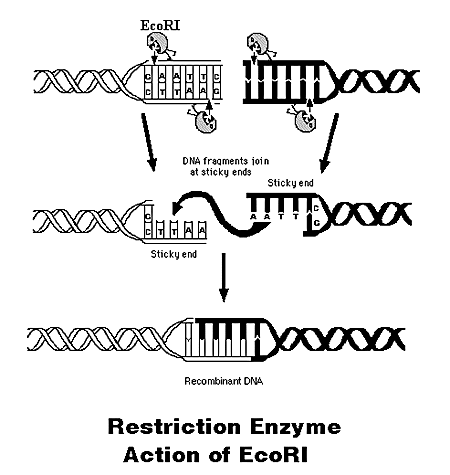
About GMOs
How are GMOs made?

GMOs are very simple to create. First the molecule to be produced is identified, then it is isolated and “cut” with restriction enzymes. The restriction enzymes “cut” the DNA at specific nucleic acid sequences. One of the most common restriction enzymes, EcoRI, is often used to make recombinant DNA for GMOs. The process of creating GMOs is basically a more advanced form of artificial selection, in which two organisms with desirable traits mate and hopefully produce a viable offspring that posses those traits. This is not always perfect, however. A lot of the times, the bad traits get moved on to the offspring, and though it may have the desirable traits, it may have also inherited the undesirable ones. That is where GMOs come in. They are much more accurate at producing organisms that have the wanted traits, because they are isolated and only those traits get put into the organism, thus eradicating any possibility of the organism inheriting negative traits.

Genetically modified organisms have existed for thousands of years. Traditionally, cross breeding was used to, hopefully, create a hybrid that had the favorable traits that were carried by the parents. This cross breeding was quite random and often times unsuccessful. However, due to new advancements in technology, the marvels of GMOs have come back to light. In 1994 the first commercial GMO hit the shelves of grocery stores in the form of Flavr Savr tomatoes. These tomatoes were genetically modified to have a delay in their ripening which made them favorable for both farmers and grocers because it meant the fruit had a longer shelf life than traditional tomatoes. This is because they were able to create a gene that reduced the amount of the PG (polygalacturonase) enzyme that drastically lengthened the time it took for the cell walls of the cell to break down, thus giving the fruit firm for much longer.
Flavr Savr Tomatoes
Challenges
The major challenges to GMOs are the people. Many consumers do not completely understand what GMOs are and how they are made. When strawberries were genetically modified to create a protein that some fish make to keep them from freezing, people began to panic thinking that there was fish in their strawberries. The other challenge that is presented to GMOs is the fact that DNA and the coding of it are not completely understood yet. Especially when it comes to the sequences of nucleic acids that do not code for anything. But once that is figured out and scientists can locate where genes are located, GMOs will be everywhere and they will make life so much better. In the coming years, scientists hope to clear up the haze that surrounds what GMOs are and how they are made, as well as perfect the process of creating GMOs and make them apart of everyday life.


Click the arrow to learn more about the issues surrounding GMOs
Timeline
1935 – DNA Discovered
Russian scientist Andrei Nikolaevitch Belozersky isolates pure DNA.
1973 – Recombinant DNA Created
The idea for man-made DNA, or rDNA, comes from a grad student at Stanford University Medical School. Professor Herbert Boyer and a few of his biologist colleagues run with it.
1975 – Asilomar Conference
A group of biologists get together with a few lawyers and doctors to create guidelines for the safe use of genetically engineered DNA.
1980 – First GMO Patent Issued
A 1980 court case between a genetics engineer at General Electric and the U.S. Patent Office is settled by a 5-to-4 Supreme Court ruling, allowing for the first patent on a living organism. The GMO in question is a bacterium with an appetite for crude oil, ready to gobble up spills.
1982 – FDA Approves First GMO
Humulin, insulin produced by genetically engineered E. coli bacteria, appears on the market.
1994 – GMO Hits Grocery Stores
The U.S. Food and Drug Administration approves the Flavr Savr tomato for sale on grocery store shelves. The delayed-ripening tomato has a longer shelf life than conventional tomatoes.
1996 – GMO-Resistant Weeds
Weeds resistant to glyphosate, the herbicide used with many GMO crops, are detected in Australia. Research shows that the super weeds are seven to 11 times more resistant to glyphosate than the standard susceptible population.
1997 – Mandatory Labels
The European Union rules in favor of mandatory labeling on all GMO food products, including animal feed.
1999 – GMO Food Crops Dominate
Over 100 million acres worldwide are planted with genetically engineered seeds. The marketplace begins embracing GMO technology at an alarming rate.
2003 – GMO-Resistant Pests
In 2003, a Bt-toxin-resistant caterpillar-cum-moth, Helicoverpa zea, is found feasting on GMO Bt cotton crops in the southern United States. In less than a decade, the bugs have adapted to the genetically engineered toxin produced by the modified plants.
2011 – Bt Toxin in Humans
Research in eastern Quebec finds Bt toxins in the blood of pregnant women and shows evidence that the toxin is passed to fetuses.
2012 – Farmer Wins Court Battle
French farmer Paul Francois sues Monsanto for chemical poisoning he claims was caused by its pesticide Lasso, part of the Roundup Ready line of products. Francois wins and sets a new precedent for future cases.
2014 – GMO Patent Expires
Monsanto’s patent on the Roundup Ready line of genetically engineered seeds will end in two years. In 2009, Monsanto introduced Roundup 2 with a new patent set to make the first-generation seed obsolete.